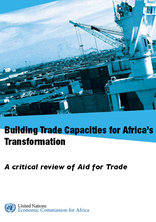Building Trade Capacities for Africa’s Transformation

At a conceptual level, the notion of Aid for Trade can be traced to the debate surrounding the Millennium Development Goal (MDG) number 8 and the “global partnership for development”.1 In practical terms, however, Aid for Trade prominently enters into the development discourse with the 2005 Hong Kong Ministerial Declaration of the World Trade Organization (WTO), where it is initially conceived as a “valuable complement” to the Doha Development Round. Since then, the stalemate of the latter and the growing importance attached to the “trade dimension” of development strategies have gradually led to a “decoupling” of Aid for Trade from the Doha negotiations (see Hallaert, 2012). Given this trajectory, at the present juncture it is all the more important to go beyond a mere monitoring of Aid for Trade flows and frame the discussions arising from the Fourth Global Review of Aid for Trade into the broader development context. The terms of integration into the global market have been changing and, in this respect, three broad tendencies appear to be crucial for Africa as well as for other developing regions.